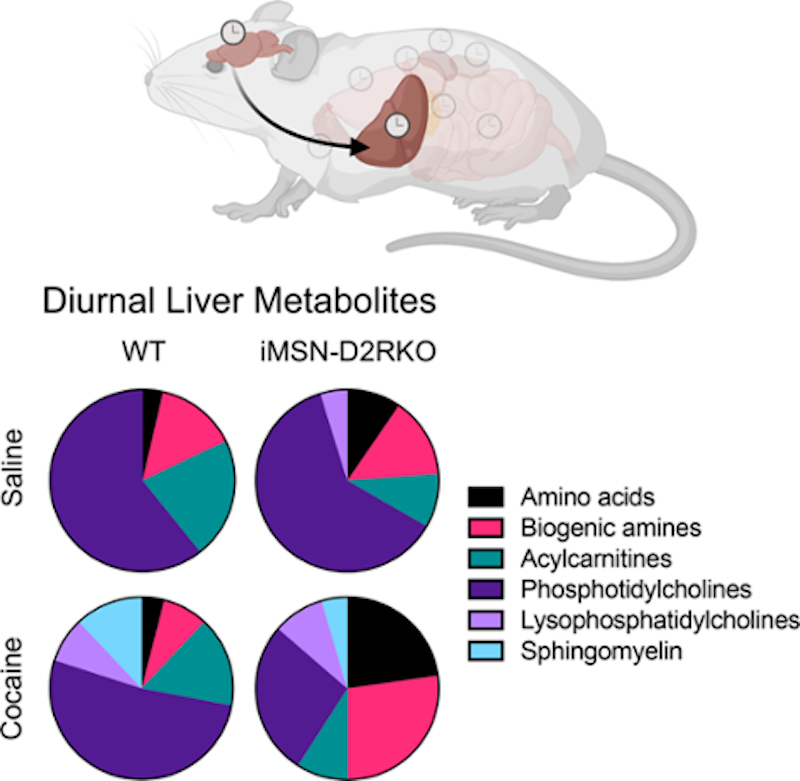New UCI-led study finds links between circadian rhythms, metabolism and addiction
Source: UCI School of Medicine

“Our studies show that alterations of dopaminergic signaling in the brain affects liver metabolism in a circadian manner. Metabolic inter-tissue communication is highly dynamic and easily influenced by external factors. Indeed, the metabolic perturbations observed between normal mice and those with an impaired dopamine D2 receptor signaling in striatal medium spiny neurons is greatly enhanced by cocaine, a substance of abuse and psychomotor stimulant, as shown in the pie charts. These results highlight the important connectivity between single type of neurons and metabolism and show how psychoactive drugs impact physiology through direct brain-liver connections,” says Emiliana Borrelli, PhD, professor of Microbiology & Molecular Genetics at UCI School of Medicine, who, for this study, collaborated with the late Paolo Sassone-Corsi, PhD, professor of Biological Chemistry at UCI.
UCI School of Medicine
Irvine, Calif., March 11, 2022 — A new University of California, Irvine-led study establishes important conceptual connections between the fields of circadian rhythms, metabolism, and addiction. Going beyond current studies on substance use disorders, which focus on the impact of addictive drugs on the brain, this new research highlights an existing connection between specific neurons and peripheral organs.
The study, titled “Dopamine D2 receptor signaling in the brain modulates circadian liver metabolomic profiles,” was published today in the Proceedings of the National Academy of Sciences.
“Our findings provide a link to substance use disorders and metabolic dysfunctions,” explained Emiliana Borrelli, PhD, professor of Microbiology & Molecular Genetics at UCI School of Medicine who, for this study, collaborated with the late Paolo Sassone-Corsi, PhD, professor of Biological Chemistry at UCI. “Through our research we explored how the disruption of normal neuronal functions affects metabolic activity and may move the body to an altered state away from homeostasis, which could contribute to the drug seeking behaviors exhibited by people with substance use disorders.”
By analyzing the liver metabolome of mice deficient in the expression of the dopamine D2 receptor (D2R) in striatal medium spiny neurons, the researchers found profound changes in the liver circadian metabolome compared to control mice. In addition, they found that activation of dopaminergic circuits by acute cocaine administration reprograms the circadian liver metabolome.
“D2R signaling in medium spiny neurons is key for striatal output and is essential for regulating the first response to the cellular and rewarding effects of cocaine,” said Borrelli. “Thus, our results suggest that changes in dopamine signaling in specific striatal neurons evoke major changes in liver physiology. Dysregulation of liver metabolism could contribute to an altered allostatic state and therefore be involved in continued use of drugs.”
The circadian clock is tightly intertwined with metabolism and relies heavily on multifaceted interactions between organ systems to maintain proper timing. Genetic and/or environmental causes can disrupt communication between organs and alter rhythmic activities. Substance use leads to altered dopamine signaling followed by reprogramming of circadian gene expression and metabolism in the reward system.
This study shows that dopamine D2 receptors (D2R) in striatal medium spiny neurons (MSNs) play a key role in regulating diurnal liver metabolic activities. In addition, drugs that increase dopamine levels, such as cocaine, disrupt circadian metabolic profiles in the liver, which is exacerbated by loss of D2R signaling in MSNs. These results uncover a strict communication between neurons/brain areas and liver metabolism as well as the association between substance use and systemic deficits,” said Borrelli.
Substance use disorders affect millions of people worldwide. The rewarding properties of substances, such as alcohol, nicotine, opioids, and psychostimulants, are linked to their ability to increase dopamine levels in brain areas that control emotions and induce pleasure. Drug intake modifies neuronal plasticity and is at the start of the process of addiction, which leads vulnerable individuals to continually seek and abuse these substances despite the adverse consequences on their lives.
This study was funded by grants from the National Institutes of Health under Award Number DA035600 and by the French Institut National de la Sante et de la Recherche Medicale (INSERM).
Future studies will examine whether the alterations in the specific metabolites identified in this study contribute to susceptibility to drug use.
